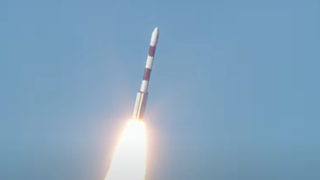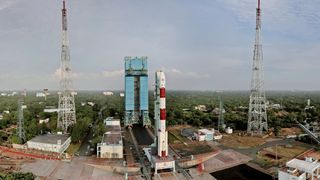A European mission that may use two satellites to create synthetic eclipses in Earth orbit launched early Thursday morning (Dec. 5) after a 24-hour delay.
The European Area Company‘s (ESA) Proba-3 formation-flying mission lifted off atop an Indian Polar Satellite tv for pc Launch Car (PSLV) from Satish Dhawan Area Heart on Thursday at 5:35 a.m. EST (1035 GMT; 4:35 p.m. native time in India).
The launch was initially scheduled to happen at 5:38 ET (1038 GMT) on Wednesday Dec.4, however the launch was scrubbed attributable to a technical problem.

“Throughout Proba3’s pre-launch preparations on the Satish Dhawan Area Centre in India, an anomaly within the redundant propulsion system of the Coronagraph Spacecraft occurred,” ESA Director-Normal Josef Aschbacher mentioned in a assertion on social media. “This propulsion system is a part of the angle and orbit management subsystem of the satellite tv for pc and used to keep up orientation and pointing in house.”

ESA additionally wrote on its X feed: “#Proba3 launch replace: As a part of customary operations within the preparation of launch, a technical problem was detected within the Proba-3 spacecraft. Liftoff is now scheduled no sooner than 5 December 10:42 GMT/11:42 CET.”
#Proba3 launch replace: As a part of customary operations within the preparation of launch, a technical problem was detected within the Proba-3 spacecraft. Liftoff is now scheduled no sooner than 5 December 10:42 GMT/11:42 CET. Be a part of us reside tomorrow➡️ https://t.co/cPbPMCWZ39 https://t.co/2QOzzP2pY8December 4, 2024
ESA and its private-sector companions started creating the 200-million-euro (about $210 million USD) Proba-3 mission again in 2014. It is the fourth flight within the company’s Proba sequence of low-cost, technology-demonstrating orbital efforts.
Associated: Proba-2 satellite tv for pc sees double when snapping photo voltaic eclipse footage from house
The opposite three are Proba-1, an Earth-observation satellite tv for pc with a novel hyperspectral instrument that launched in 2001; Proba-2, a sun-studying spacecraft with greater than 20 know-how and science payloads that took flight in 2009; and Proba-V, which launched in 2012 to map Earth’s vegetation (the “V” within the mission’s title) utilizing modern science gear.
All of those predecessors are nonetheless going robust in Earth orbit.
Proba-3 consists of two satellites, which collectively weigh about 1,210 kilos (550 kilograms). If all goes in response to plan on Thursday, the four-stage, 146-foot-tall (44.5 meters) PSLV will ship this duo to a extremely elliptical orbit, one which takes them 37,612 miles (60,530 kilometers) from Earth at their most distant level and simply 373 miles (600 km) away at their closest.
“After a brief preparatory interval, the 2 satellites shall be separated and injected right into a secure relative tandem orbit,” ESA officers wrote in a Proba-3 mission description. “Included within the commissioning interval shall be an indication of the mission’s Collision Avoidance Maneuver, making certain they are often left safely in an orbit with no danger of collision or working away from one another.”
Then the mission’s actual work will start — an indication of formation flying, the likes of which we have by no means seen earlier than.
“As a world first, its two satellites — the Coronagraph spacecraft and the Occulter spacecraft — will keep formation to some millimeters and arc second precision at distances of round 150 meters [492 feet] for six hours at a time,” ESA officers wrote. “In impact, the pair shall be forming a digital large satellite tv for pc. And this shall be achieved autonomously, with out counting on steerage from the bottom.”
Whereas aligned on this extremely exact vogue, the Occulter will block the solar’s disk from the Coronagraph’s perspective, creating a complete photo voltaic eclipse for the latter spacecraft. It will permit the Coronagraph to review the corona, the solar’s wispy, unfathomably scorching outer ambiance, which is often misplaced in our star’s glare.
“In comparison with a complete eclipse [on Earth], every certainly one of which which lasts just some minutes and happens solely round 60 occasions a century, Proba-3 will have the ability to research the corona for six hours in each 19hr 36min orbit, an element of 100 enchancment in uninterrupted research time,” ESA officers wrote within the mission description.
Proba-3, which is anticipated to function for at the very least two years, may due to this fact assist scientists resolve some solar mysteries, together with why the corona is so scorching and the way the photo voltaic wind will get accelerated to such great speeds. However the formation-flying applied sciences it is going to show out could find yourself being the mission’s most lasting legacy.
“Attaining exact formation flying opens up an entire new period for science and functions,” ESA officers wrote. “Future missions could possibly be assembled on a a lot bigger scale. Purposes of curiosity embody Earth statement in addition to in-orbit satellite tv for pc servicing.”

